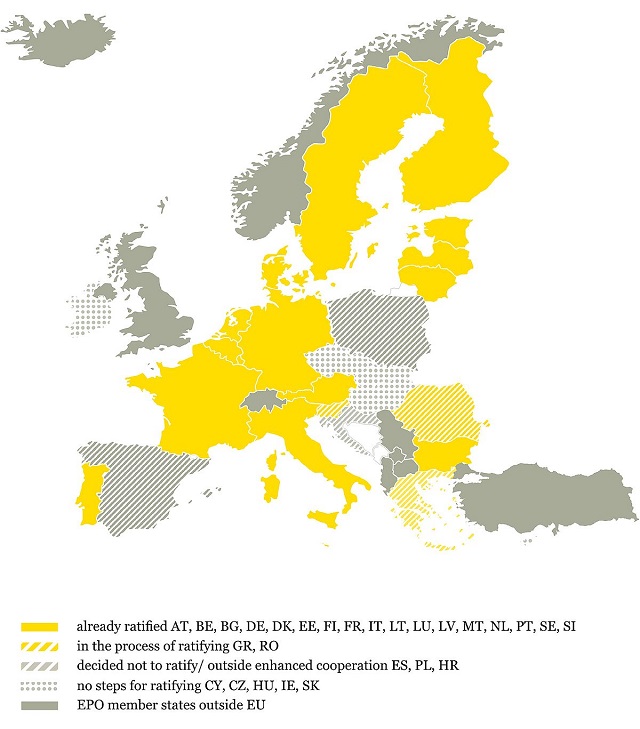A. What will change and what will be the timeline?
Currently, it is expected that the first Unitary Patents can be granted later this year. Once the Agreement on a Unified Patent Court (UPCA) enters into force, which is expected towards the end of 2022, "unitary effect" can be requested for any European patent granted thereafter. Currently, the Unitary Patent would have a "unitary effect" in 17 countries, including France, Germany, Italy, and the Netherlands, among others. After the UPCA becomes effective, a European patent will no longer have to be validated individually in those 17 countries, and only a single renewal fee will have to be paid centrally at the European Patent Office (EPO) for each Unitary Patent, instead of 17 renewal fees at the 17 individual national patent offices. For the other countries, in which a European patent can be validated but which do not belong to the new system (such as the United Kingdom or Spain), the bundle patent and the need for national validation will remain.
Once the new system starts, the newly created Unified Patent Court (UPC) will have exclusive competence with respect to questions of both the infringement and validity of Unitary Patents. However, the UPC will generally also have competence in existing and future European bundle patents. For Unitary Patents and bundle patents a central decision on infringement and validity can then be issued. A decision will uniformly take effect for all 17 countries of the new system in the case of a Unitary Patent or, in the case of a bundle patent, for those of the 17 countries in which the bundle patent has been validated. In contrast to Unitary Patents, during a transitional period of seven to 14 years, both the national courts and the UPC will have competence over bundle patents. During the same transitional period, the competence of the UPC can be excluded by the patent proprietor for the entire term of a bundle patent by a declaration of an opt-out.
The question whether applicants should request a Unitary Patent or rather continue with the bundle patent, which still remains an option for all countries of the UPCA, will thus arise very soon. Even if applicants want to stick to the proven bundle patent at least for the time being, the question arises whether they want to subject their bundle patents to the competence of the newly created UPC (as well) or exclude this by opting them out of that system.
The current 17 participating countries are highlighted in yellow in the following overview.

B. How and when can Unitary Patents be obtained?
The grant procedure remains the same as before: Applicants file a European patent application at the EPO. After grant, there is the option to convert the granted bundle patent into a Unitary Patent for the current 17 member countries by filing a corresponding request for unitary effect.
The request for unitary effect may be filed for all patents granted by the EPO after the entry into force of the UPCA within one month from the date the mention of grant is published. The UPCA will enter into force approximately three to four months after Germany deposits its instrument of ratification (more precisely: on the first day of the fourth month after the deposit). The deposit is expected as of mid-2022, i.e., the UPCA should enter into force at the end of 2022 or the beginning of 2023 at the latest.
No official fee will have to be paid for the request for unitary effect. However, a full translation of the patent is required. But the translation will only be informative in nature and also only needs to be filed during a transitional period of six to twelve years. If the patent is in German or French, an English translation is required. If the patent has been granted in English, the translation can be filed in any language of the European Union.
To ensure that the Unitary Patent can be used promptly, the EPO has adopted two transitional measures which can be used from the date of the deposit of the instrument of ratification by Germany. Firstly, the grant of European patents can be postponed until after the entry into force of the UPCA1, so that they can be converted into Unitary Patents. Secondly, a request for unitary effect can already be filed for applications intended for grant2, so that unitary effect can occur immediately after the UPCA enters into force.
C. Costs, advantages, and disadvantages of the Unitary Patent
In the case of a bundle patent, renewal fees are payable separately in all contracting states of the EPC in which it has been validated; in some contracting states, translation costs for validation are also due. In contrast, for the Unitary Patent, only a single renewal fee has to be paid to the EPO, to which the costs of the required translation are currently still added. The renewal fees for the Unitary Patent were determined based on the "True Top 4" model3. They roughly correspond to the fees that would be payable for patents validated in Germany, France, the Netherlands, and the United Kingdom. Brexit and thus the departure of the United Kingdom, which had originally been part of the new system, has not yet been taken as an opportunity to readjust the renewal fees.
As compared to validating a bundle patent in all current 17 member countries of the new system, the Unitary Patent offers a significant cost reduction over its lifetime (approx. -60%). However, many European patents are currently validated only in Germany, France, and the United Kingdom. A corresponding coverage of these countries by a Unitary Patent and a bundle patent validated in the United Kingdom would result in significantly higher costs (approx. +60%) compared to the pure bundle patent solution. Even when taking into account lower administrative costs of the validation and of the monitoring of the individual renewal fees, a Unitary Patent would only be cheaper than a bundle patent if the latter was validated in two additional countries already covered by the Unitary Patent (e.g., Italy and the Netherlands). For patents from the pharmaceutical sector, this is to be expected more frequently, whereas it seems to be the exception in many other sectors.
The Unitary Patent offers the advantage of simpler and less costly enforcement in all of the current 17 countries with a single action. However, the enforcement of a bundle patent with a single action in all those of the currently 17 countries in which the bundle patent has been validated will also be possible, provided that no opt-out has been declared. With the Unitary Patent, the patent proprietor loses the flexibility offered by the bundle patent during the long transitional period, namely, to choose between enforcement at the UPC and the national courts. It should also be borne in mind that the Unitary Patent eliminates the possibility of reducing the fee burden during the term by dropping individual countries – which is possible with bundle patents.
For a decision in favor of a bundle patent or in favor of a Unitary Patent, the circumstances of the individual case must therefore be examined. There are arguments in favor of requesting a Unitary Patent only if there is an interest in patent protection in a large number of member countries of the UPCA.
D. Should an opt-out be declared for bundle patents?
Within a transitional period of seven to 14 years, the opt-out can be declared for a bundle patent in order to remove it from the competence of the UPC. An official fee is no longer provided for this. An opt-out is valid for the entire lifetime of the respective patent but can be withdrawn at any time. However, opting out a bundle patent is no longer possible if an action has already been filed with the UPC concerning that bundle patent. Conversely, the withdrawal of the opt-out is ruled out if a national action concerning the patent has already been filed.
By opting out the patent of the new system, the patent proprietor can no longer uniformly assert the bundle patent in one action. However, it also avoids the risk of revocation in all UPCA countries where the bundle patent is validated by a central invalidity action before the UPC. Rather, validity can then only be attacked nationally – apart from opposition proceedings at the EPO, which will continue to exist.
It is often argued that proprietors should opt out their "crown jewels" of the UPC in order to avoid the risk of a central revocation. However, this does not always seem justified: Depending on the objective pursued, enforcing valuable patents centrally is an opportunity of the new system which is a reason against the opt-out. Moreover, the specter of "central invalidity" may have lost some of its threat with the departure of the United Kingdom, since even in the event of a revocation before the UPC, a bundle patent would remain in force in Europe's second largest market.
The opt-out should therefore be examined in a targeted manner. A mass flight from the UPC does not seem justified.
The UPC will have exclusive competence over all bundle patents granted after the transitional period of seven to 14 years in any case. An opt-out will not be possible for these patents.
E. Accompanying protection by national patents is possible
In addition to the Unitary Patent and the bundle patent, applicants can still file national patent applications. As before, the national courts remain competent for nationally granted patents. An interesting additional option is an accompanying national double protection. Until now, it was not possible to effectively obtain patent protection for a European patent validated in Germany and a parallel German patent as far as it claims the same subject matter. This will change with the entry into force of the UPCA: A German patent and an identical Unitary Patent or an identical European bundle patent can be effectively granted as long as, in the case of a bundle patent, no opt-out has been declared. The patent proprietor would then have the choice to assert either the German patent at the German civil courts or the European patent at the UPC, even after the transitional period. This will also be possible in some other countries of the UPCA, e.g., France.
Footnotes
1 Official Journal of the EPO 2022, A5
2 Official Journal of the EPO 2022, A6
3 For details of the rates, see the table of fees in Art. 2 of the Rules relating to Fees for Unitary Patent Protection, Official Journal of the EPO 2016, A40
The content of this article is intended to provide a general guide to the subject matter. Specialist advice should be sought about your specific circumstances.




